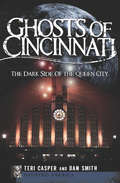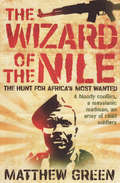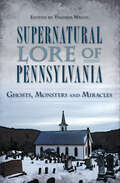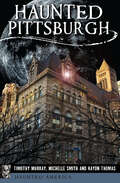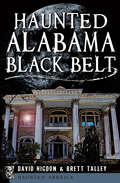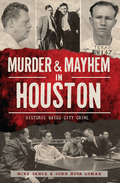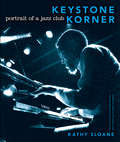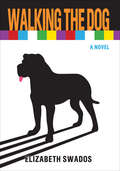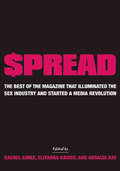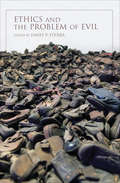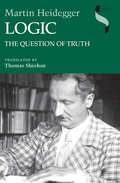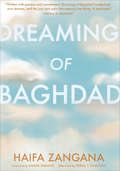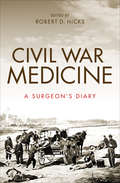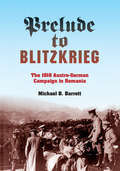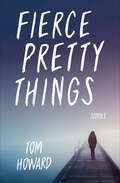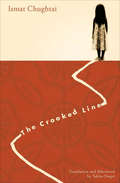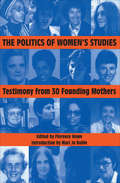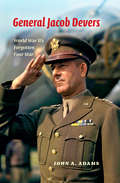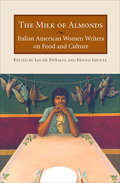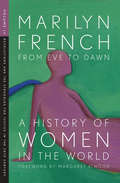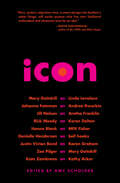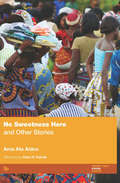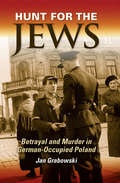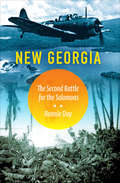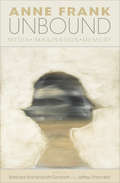- Table View
- List View
Ghosts of Cincinnati: The Dark Side of the Queen City (Haunted America)
by Dan Smith Teri CasperCincinnati chills are on the menu, as two ghost tour guides serve up the most terrifying tales from this Ohio River city&’s haunted history. A ghostly captain who forever guards her steamboat, an elusive lady in green who roams Carew Tower, spectral lovers who reunite in museum halls, these are among the souls who walk Cincinnati&’s forgotten paths. Take a chilling tour with Teri Casper and Dan Smith, owners of Cincinnati Tours, Inc., as they recount the infamous murder of Imogene Remus by her bootlegger husband and recall the tale of a young World War II soldier who is still searching for a way home from Union Terminal. Wander among the lonely mausoleums of Spring Grove Cemetery and listen for strange echoes in Music Hall to meet the otherworldly residents of the Queen City. Includes photos!
The Wizard of the Nile: The Hunt for Africa's Most Wanted
by Matthew GreenA foreign correspondent&’s chronicle of the Ugandan warlord and his Lord&’s Resistance Army of abducted child soldiers: &“a readable and compelling account&” (Independent, UK). Somewhere in the jungles of Uganda, there hides a fugitive rebel leader: he is said to take his orders directly from the spirit world and, together with his ragged army of brutalized child soldiers, he has left a bloody trail of devastation across his country. Joseph Kony is now an internationally wanted criminal, and yet nobody really knows who he is or what he is fighting for. To get the truth behind the rumors and myths, Matthew Green ventures into the war zone, meeting the victims, the peacemakers and the regional powerbrokers as he tracks down the man himself. The Wizard of the Nile is the first book to peel back the layers of mysticism and murky politics surrounding Kony, to shine a searching light onto this forgotten conflict, and to tell the gripping human story behind an inhumane war and a humanitarian crisis. Winner of the Jerwood AwardLong-listed for the Orwell Prize
Supernatural Lore of Pennsylvania: Ghosts, Monsters and Miracles (American Legends Ser.)
by Thomas WhiteLocal legends and paranormal mysteries of Pennsylvania—photos included. Strange creatures and tales of the supernatural thrive in Pennsylvania, from ghostly children who linger by their graves to werewolves that ambush nighttime travelers. Passed down over generations, Keystone State legends and lore provide both thrilling stories and dire warnings. Phantom trains chug down the now removed rails of the P&LE Railroad line on the Great Allegheny Passage. A wild ape boy is said to roam the Chester swamps, while the weeping Squonk wanders the hemlock-shrouded hills of central Pennsylvania, lamenting his hideousness. On dark nights, the ghosts of Betty Knox and her Union soldier beau still search for each other at Dunbar Creek. Join Thomas White and company as they go in search of the truth behind the legends of supernatural Pennsylvania.
Haunted Pittsburgh (Haunted America)
by Michelle Smith Timothy Murray Haydn ThomasA ghost tour team mines the Steel City&’s past for the stories of spirits that stalk its streets today. Founded amidst the bloodshed of the French and Indian War, Pittsburgh is haunted by the ghosts of its gritty and sometimes violent past. Many believe American industrialist Henry Clay Frick still inhabits Clayton, one of the last surviving homes on Millionaires&’ Row. The spirit of Kate Soffel lingers at the Allegheny County Jail, where she helped plot the escape of the Biddle brothers and fell in love in the process. The Duquesne Incline in 1877 employed teens disguised as ghosts to boost business. However, an authentic sinister entity is said to haunt the nearby Monongahela Incline without compensation. Join the Haunted Pittsburgh team as it explores ghostly encounters in the Steel City. Includes photos! &“Tales that connect the region to the spirit world.&” —Trib Live
Haunted Alabama Black Belt (Haunted America)
by David Higdon Brett TalleyDiscover the ghosts that wander this historic stretch of the South . . . photos included. There is a place in Alabama, a region that stretches across its lower middle from Georgia to Mississippi. It is a place steeped in history—a place where a people were enslaved, a nation was broken, and a new dream of freedom was born. It is a place where the past is always near at hand. And sometimes, that past takes a moment to whisper in your ear. They call this place the Black Belt. From the Cato-Thorn House in Barbour County to the Snow Hill Institute in Wilcox County, Alabama&’s Black Belt has a great number of restless spirits that still haunt it. Join paranormal researcher David Higdon and Bram Stoker Award nominee Brett Talley as they uncover the ghosts and hauntings of one of Alabama&’s most historic areas.
Murder & Mayhem in Houston: Historic Bayou City Crime (Murder And Mayhem Ser.)
by John Nova Lomax Mike VanceHouston, we have a problem. The largest city in Texas has a wild west past filled with dodgy criminals and murderous madmen. When the Allen brothers sold Houston&’s first lots, the city became a magnet for enterprising tycoons and opportunistic crooks alike. As the young city grew, a scourge of crime and vice accompanied the success of oil and real estate. The Bayou City&’s seedy side—flashing Bowie knives, privileged bad boys, hardened prostitutes and unchecked serial killers—established its hold. From a young Clyde Barrow to the Man Who Killed Halloween, Houston&’s past is filled with bloody tales, heartbreaking loss and despicable deeds. Authors Mike Vance and John Nova Lomax shine a light on these dark days. Includes photos!
Keystone Korner: Portrait of a Jazz Club
by Kathy SloaneThe award-winning photographer&’s pictorial history of the famous San Francisco Jazz club featuring oral histories and more than 100 images—&“A treasure&” (SF Weekly). In the words of Wynton Marsalis, &“Keystone Korner was the quintessential jazz club . . . a happy home to people of all persuasions.&” During the 1970s, when jazz clubs across America were folding under the onslaught of rock and roll and disco, San Francisco&’s Keystone Korner was an oasis for jazz listeners and musicians. Tucked away in the city&’s North Beach area, the Keystone became one of the most important jazz spots in the United States. It was so beloved by musicians that superstars McCoy Tyner, Freddie Hubbard, Ron Carter, and Elvin Jones played a benefit concert to raise money for its liquor license. In this book, award-winning photographer Kathy Sloane shares more than 100 black and white photographs documenting the musicians and regulars, the spontaneous moments and ephemeral scene of this legendary club. Together with these images, she has compiled a fascinating collage of first-hand oral histories that chronicle the Keystone experience. &“From the antics of the photo-laden backroom to the underground hype of Ora Harris&’ Keystone Kitchen, Sloane and fellow editor Sascha Feinstein leave no stone unturned. They examine the backstories of some of Keystone&’s most lovable characters . . . a delightful sensory overload&” (Downbeat).
Walking the Dog: A Novel
by Elizabeth SwadosA &“brilliant and layered&” novel about a prodigy turned convict turned dog walker in her 40s from the celebrated author of My Depression: A Picture Book (Oprah.com). A former child prodigy and rich-girl, eighteen-year-old Ester is incarcerated after her kleptomania gets way out of hand. There, she is given the very gentile name Carleen (for her own protection) and for two decades, time is the enemy. When finally let loose onto the streets of New York, Carleen finds a job as a dog walker in Manhattan&’s most elite neighborhoods. But despite her remarkable gift for canine communication, Carleen is determined to finally prove that she is a real person. To this end, she tries to reconnect with her estranged—and ferociously Orthodox—daughter. Amid the strained brunch dates, unsent letters, and the continuing trauma of prison, Carleen begins a slow and halting process of self-discovery. Strikingly funny and self-aware, this belated coming-of-age novel asks the question: How do you restart after crashing your first chance at life?
$pread: The Best of the Magazine that Illuminated the Sex Industry and Started a Media Revolution
by Edited By Rachel Aimee, Eliyanna Kaiser and Audacia Ray&“A fascinating collection from a group of courageous women who created the first publication to explore sex work in a compelling and intelligent way.&” —Candida Royalle $pread, an Utne Award–winning magazine by and for sex workers, was independently published from 2005 to 2011. This collection features enduring essays about sex work around the world, first-person stories that range from deeply traumatic to totally hilarious, analysis of media and culture, and fantastic illustrations and photos produced just for the magazine. The book also features the previously untold story of $pread and how it has built a wider audience in its posthumous years. What started as a community tool and trade magazine for the sex industry quickly emerged as the essential guide for people curious about sex work, for independent magazine enthusiasts, and for labor and civil rights activists.
Ethics and the Problem of Evil (Indiana Series in the Philosophy of Religion)
by John Hare Laura Garcia Stephen Maitzen Bruce Russell Marilyn McCord Adams Linda Zagzebski Stephen J. WykstraProvocative essays that seek &“to turn the attention of analytic philosophy of religion on the problem of evil . . . towards advances in ethical theory&” (Reading Religion). The contributors to this book—Marilyn McCord Adams, John Hare, Linda Zagzebski, Laura Garcia, Bruce Russell, Stephen Wykstra, and Stephen Maitzen—attended two University of Notre Dame conferences in which they addressed the thesis that there are yet untapped resources in ethical theory for affecting a more adequate solution to the problem of evil. The problem of evil has been an extremely active area of study in the philosophy of religion for many years. Until now, most sources have focused on logical, metaphysical, and epistemological issues, leaving moral questions as open territory. With the resources of ethical theory firmly in hand, this volume provides lively insight into this ageless philosophical issue. &“These essays—and others—will be of primary interest to scholars working in analytic philosophy of religion from a self-consciously Christian standpoint, but its audience is not limited to such persons. The book offers illustrative examples of how scholars in philosophy of religion understand their aims and how they go about making their arguments . . . hopefully more work will follow this volume&’s lead.&”—Reading Religion &“Recommended.&”—Choice
Logic: The Question of Truth (Studies in Continental Thought)
by Martin HeideggerHeidegger&’s radical thinking on the meaning of truth in a &“clear and comprehensive critical edition&” (Philosophy in Review). Martin Heidegger&’s 1925–26 lectures on truth and time provided much of the basis for his momentous work, Being and Time. Not published until 1976—three months before Heidegger&’s death—as volume 21 of his Complete Works, it is nonetheless central to Heidegger&’s overall project of reinterpreting Western thought in terms of time and truth. The text shows the degree to which Aristotle underlies Heidegger&’s hermeneutical theory of meaning. It also contains Heidegger&’s first published critique of Husserl and takes major steps toward establishing the temporal bases of logic and truth. Thomas Sheehan&’s elegant and insightful translation offers English-speaking readers access to this fundamental text for the first time.
Dreaming of Baghdad (Women Writing The Middle East Ser.)
by Haifa Zangana&“With passion and commitment,&” an exiled Iraqi woman recounts her time organizing resistance to Saddam Hussein and imprisonment in Abu Ghraib (Nawal El Saadawi, author of Zeina). In 1970s Iraq, the Ba&’ath Party was at the height of its influence in the Middle East and popularity throughout the West. But a group of activists recognized the disastrous potential of the regime as its charismatic leader, Saddam Hussein, came to power. Haifa Zangana was among those who resisted Saddam&’s rule, a small group of whom were captured and imprisoned at Abu Ghraib. Now, from a distance of time and place, Zangana writes about her incarceration, the agonizing loss of comrades to torture and death in prison, her safe yet haunted life so far away from friends, family, and her beloved country, and the ways memory conspires to make us forget. In this poetic, emotionally-tinged memoir, the author of Women on a Journey: Between Baghdad and London &“drags politics down from the realm of the abstract into the mud, fear, and loneliness of personal experience and psychological ruin that is life under dictatorship&” (Christian Parenti, author of The Freedom: Shadows and Hallucinations in Occupied Iraq).
Civil War Medicine: A Surgeon's Diary
by Randall M. Miller Shauna Devine Margaret Humphreys Guy R. Hasegawa James M. Edmonson Barbra Mann Wall&“An incredible resource for anyone interested in the human experience of the Civil War―as recorded by a medical professional tasked with saving lives.&”—David Price, Executive Director of the National Museum of Civil War Medicine In this never before published diary, twenty-nine-year-old surgeon James Fulton transports readers into the harsh and deadly conditions of the Civil War as he struggles to save the lives of the patients under his care. Fulton joined a Union army volunteer regiment in 1862, only a year into the Civil War, and immediately began chronicling his experiences in a pocket diary. Despite his capture by the Confederate Army at Gettysburg and the confiscation of his medical tools, Fulton was able to keep his diary with him at all times. He provides a detailed account of the next two years, including his experiences treating the wounded and diseased during some of the most critical campaigns of the war, and his relationships with soldiers, their commanders, civilians, other health-care workers, and the opposing Confederate army. The diary also includes his notes on recipes for medical ailments from sore throats to syphilis. In addition to Fulton&’s diary, editor Robert D. Hicks and experts in Civil War medicine provide context and additional information on the practice and development of medicine during the Civil War, including the technology and methods available at the time; the organization of military medicine; doctor-patient interactions; and the role of women as caregivers and relief workers. Civil War Medicine: A Surgeon&’s Diary provides a compelling new account of the lives of soldiers during the Civil War and a doctor&’s experience of one of the worst health crises ever faced by the United States.
Prelude to Blitzkrieg: The 1916 Austro-German Campaign in Romania (Twentieth-Century Battles)
by Michael B. BarrettAn authoritative study of World War I&’s often-overlooked Romanian front. In contrast to the trench-war deadlock on the Western Front, combat in Romania and Transylvania in 1916 foreshadowed the lightning warfare of World War II. When Romania joined the Allies and invaded Transylvania without warning, the Germans responded by unleashing a campaign of bold, rapid infantry movements, with cavalry providing cover or pursuing the crushed foe. Hitting where least expected and advancing before the Romanians could react―even bombing their capital from a Zeppelin soon after war was declared―the Germans and Austrians poured over the formidable Transylvanian Alps onto the plains of Walachia, rolling up the Romanian army from west to east, and driving the shattered remnants into Russia. Prelude to Blitzkrieg tells the story of this largely ignored campaign to determine why it did not devolve into the mud and misery of trench warfare, so ubiquitous elsewhere. &“This work will stand as the definitive study of the Central Powers part of the campaign for some time to come.&” —Journal of Military History &“Barnett&’s book is a valuable addition to the field. He writes well and with authority. He has been able to illuminate a little-known corner of the First World War and provide a state-of-the-art operational history combining detailed narrative with prescient analysis.&” —American Historical Review
Fierce Pretty Things: Stories (Blue Light Books)
by Tom HowardThis debut story collection from the Tobias Wolff Award–winning author &“is streaked with fantasy that deconstructs society&’s lost and wasted lives&” (Publishers Weekly). In these eight darkly comic stories, acclaimed author Tom Howard explores the conflicting instincts for tenderness and violence that mark his character&’s lives. A brother and sister wander the pier after a deadly plague destroys most of humanity. A high school bully struggles to overcome his demons. A man in the grips of dementia is visited by his children&’s ghosts. The people in these tales grapple with past mistakes, trying to navigate their way toward redemption and resurrection. Though they often fail, they strive with ferocious hearts as their voices guide us through schoolyards, cemeteries, drive-in theaters, and the rich landscapes of their own imaginations.
The Crooked Line (Women Writing The Middle East Ser.)
by Ismat ChughtaiA young Indian woman searches for her own identity as her country fights for independence in this novel from the award-winning Urdu Indian author. The Crooked Line is the story of Shamman, a spirited young woman who rebels against the traditional Indian life of purdah, or female seclusion, that she and her sisters are raised in. Shipped off to boarding school by her family, Shamman grows into a woman of education and independence just as India itself is fighting to throw off the shackles of colonialism. Shamman&’s search for her own path leads her into the fray of political unrest, where her passion for her country&’s independence becomes entangled with her passion for an Irish journalist. In this semi-autobiographical novel, Ismat Chughtai explores the complex relationships between women caught in a changing culture, and exposes the intellectual and emotional conflicts at the heart of India&’s battle for an uncertain future of independence from the British Raj and ultimately Partition.
The Politics of Women's Studies: Testimony from 30 Founding Mothers (The\women's Studies History Ser.)
by Edited by Florence Howe and Introduction by Mari Jo BuhleThe true stories of those bold women who espoused feminism in the world of academia and forever changed our educational system and culture. In the patriarchal halls of 1970s academe, women who spoke their minds risked their careers. Yet intrepid women—students, faculty, administrators, members of the community—persisted in collaborating on women&’s studies programs. In doing so, they created a movement that altered paradigms, curricula, teaching styles, and content across disciplines. In these original essays &“we hear the voices of feminists exhilarated by the opportunities and challenges of creating women&’s studies programs in American colleges and universities, nurtured by the women&’s movement of the 1970s,&” from young graduate students and newly hired faculty to tenured professors in search of ways to improve their students&’ capacities to learn, veteran academics at last witnessing change, and even a few administrators (Library Journal). In all of these programs, these &“founding mothers&” grappled not only with issues of gender, but with those of class, race, and sexuality in a decade infused with political unrest and questioning, when civil rights and anti-war activism, as well as feminism, shaped academic worlds.
General Jacob Devers: World War II's Forgotten Four Star
by John A. AdamsA &“solid and informative&” biography of one of the overlooked heroes of the Second World War (Wall Street Journal). Of the leaders of the American Army in World War II, Jacob Devers is undoubtedly the &“forgotten four-star.&” Plucked from relative obscurity in the Canal Zone, Devers was one of four generals selected by General of the Army George Marshall in 1941 to assist him in preparing the Army for war. He quickly became known in Army circles for his &“can do&” attitude and remarkable ability to cut through red tape. Among other duties, he was instrumental in transforming Ft. Bragg, then a small Army post, into a major training facility. As head of the armored force, Devers contributed to the development of a faster, more heavily armored tank, equipped with a higher velocity gun that could stand up to the more powerful German tanks, and helped to turn American armor into an effective fighting force. In spring 1943, Devers replaced Dwight Eisenhower as commander of the European Theater of Operations, then was given command of the 6th Army Group that invaded the south of France and fought its way through France and Germany to the Austrian border. In the European campaign to defeat Hitler, Eisenhower had three subordinate army group commanders: British Field Marshall Bernard Montgomery, Omar S. Bradley, and Jacob Devers. The first two are well-known; here the third receives the attention he properly deserves.
The Milk of Almonds: Italian American Women Writers on Food and Culture
by Edited by Louise DeSalvo and Edvige Giunta&“A vast, thoroughly wonderful assortment of poetry, memoirs and stories . . . that defines today&’s female Italian-American experience&” (Publishers Weekly). Often stereotyped as nurturing others through food, Italian-American women have often struggled against this simplistic image to express the realities of their lives. In this unique collection, over 50 Italian-American female writers speak in voices that are loud, boisterous, sweet, savvy, and often subversively funny. Drawing on personal and cultural memories rooted in experiences of food, they dissolve conventional images, replacing them with a sumptuous, communal feast of poetry, stories, and memoir. This collection also delves into unexpected, sometimes shocking terrain as these courageous authors bear witness to aspects of the Italian American experience that normally go unspoken—mental illness, family violence, incest, drug addiction, AIDS, and environmental degradation. As provocative as it is appetizing, &“this collection of verse and prose pieces . . . reveals the evocative and provocative power of food as event and as symbol, as well as the diversity of these women&’s lives and their ambivalence regarding the role of nurturer&” (Library Journal).
From Eve to Dawn: Revolutions and the Struggles for Justice in the 20th Century (Origins #4)
by Marilyn FrenchThe conclusion of the &“remarkable&” four-volume history by the New York Times–bestselling author of The Women&’s Room (Publishers Weekly). In the twentieth century, women became a force for change, in part through suffrage, and in part through mass organizing. This final volume of Marilyn French&’s wide-ranging survey offers a vibrant history of multiple political revolutions as well as the century&’s horrors—including genocides and the atom bomb. It ends with a thoughtful investigation into the various indigenous feminist movements throughout the world and asks what these peaceful revolutions might augur for the future. Eschewing easy answers, French suggests that the defining moral moments of the twenty-first century should, and will, build from a global human rights agenda.
Icon
by Mary Gaitskill Johanna Fateman&“In this collection commissioned by Amy Scholder, nine original essays explore the specific and personal impact of cultural icons.&” —Publishers Weekly Whose poster hung on your wall as a teenager? Whose record did you wear out? Whose life story could you not resist? Fascination works in mysterious ways—it can be born out of inspiration, or repulsion, or both. In these daring essays, some of the most provocative writers of our time offer a private view on a public figure. In the process, they reveal themselves in beautiful and unexpected ways, blurring the line between biography and memoir. Original essays include Introduction by Amy Scholder, Mary Gaitskill on Linda Lovelace, Rick Moody on Karen Dalton, Johanna Fateman on Andrea Dworkin, Danielle Henderson on bell hooks, Hanne Blank on MFK Fisher, Kate Zambreno on Kathy Acker, Justin Vivian Bond on Karen Graham, Jill Nelson on Aretha Franklin, and Zoe Pilger on Mary Gaitskill &“A smart plunge into fandom&’s sober fringe.&” —Wayne Koestenbaum, author of My 1980s and Other Essays
No Sweetness Here: And Other Stories
by Ama Ata AidooFrom the author of Changes: these stories &“of post-independence Ghana in the late 1960s are written beautifully and wisely and with great subtlety&” (Chimamanda Ngozi Adichi). In this short story collection, the award-winning poet and author of Changes and Our Sister Killjoy explores postcolonial life in Ghana with her characteristic honesty, humor, and insight. A house servant wonders what independence means in a country where indoor plumbing is still reserved for bosses. A brother tracks down his runaway sister only to find she has become a prostitute. In the title story, a bitter divorce turns tragic when the couple&’s only child dies of a snake bite. In these and other stories, tradition wrestles with new urban influences as Africans try to sort out their identity in a changing culture, and &“even at her gravest, Miss Aidoo writes with a sunny charm&” (The New York Times).
Hunt for the Jews: Betrayal and Murder in German-Occupied Poland
by Jan GrabowskiA revealing account of Polish cooperation with Nazis in WWII—a &“grim, compelling [and] significant scholarly study&” (Kirkus Reviews). Between 1942 and 1943, thousands of Jews escaped the fate of German death camps in Poland. As they sought refuge in the Polish countryside, the Nazi death machine organized what they called Judenjagd, meaning hunt for the Jews. As a result of the Judenjagd, few of those who escaped the death camps would survive to see liberation. As Jan Grabowski&’s penetrating microhistory reveals, the majority of the Jews in hiding perished as a consequence of betrayal by their Polish neighbors. Hunt for the Jews tells the story of the Judenjagd in Dabrowa, Tarnowska, a rural county in southeastern Poland. Drawing on materials from Polish, Jewish, and German sources created during and after the war, Grabowski documents the involvement of the local Polish population in the process of detecting and killing the Jews who sought their aid. Through detailed reconstruction of events, &“Grabowski offers incredible insight into how Poles in rural Poland reacted to and, not infrequently, were complicit with, the German practice of genocide. Grabowski also, implicitly, challenges us to confront our own myths and to rethink how we narrate British (and American) history of responding to the Holocaust&” (European History Quarterly).
New Georgia: The Second Battle for the Solomons (Twentieth-Century Battles)
by Ronnie Day&“A detailed, up-to-date, integrated air-land-sea history&” of a pivotal WWII campaign in the Pacific from both American and Japanese perspectives (Vincent P. O'Hara, author of In Passage Perilous). In 1942, the Solomon Islands formed the stepping stones toward Rabaul, the main base of Japanese operations in the South Pacific, and the Allies&’ primary objective. The stunning defeat of Japanese forces at the Naval Battle of Guadalcanal in November marked the turning point in the war against Japan and the start of an offensive in the Central Solomons aimed at New Georgia. New Georgia: The Second Battle for the Solomons tells the story of the land, sea, and air battles fought there from March through October 1943. Making careful and copious use of both Japanese and Allied sources, Ronnie Day masterfully weaves the intricate threads of these battles into a well-crafted narrative of this pivotal period in the war. As Day makes clear, combat in the Solomons exemplified the war in the Pacific, especially the importance of air power, something the Japanese failed to understand until it was too late, and the strategy of island hopping, bypassing Japanese strongholds (including Rabaul) in favor of weaker or more strategically advantageous targets. This multifaceted account gives the fighting for New Georgia its proper place in the history of the drive to break the Japanese defensive perimeter and bring the homeland within range of Allied bombers.
Anne Frank Unbound: Media, Imagination, Memory (The Modern Jewish Experience)
by Barbara Kirshenblatt-Gimblett and Jeffrey Shandler&“A brilliantly conceived and long overdue opening up [or deconstruction] of the Anne Frank story.&” —James Clifford, Professor Emeritus, History of Consciousness Department, University of California As millions of people around the world who have read her diary attest, Anne Frank, the most familiar victim of the Holocaust, has a remarkable place in contemporary memory. Anne Frank Unbound looks beyond this young girl&’s words at the numerous ways people have engaged her life and writing. Apart from officially sanctioned works and organizations, there exists a prodigious amount of cultural production, which encompasses literature, art, music, film, television, blogs, pedagogy, scholarship, religious ritual, and comedy. Created by both artists and amateurs, these responses to Anne Frank range from veneration to irreverence. Although at times they challenge conventional perceptions of her significance, these works testify to the power of Anne Frank, the writer, and Anne Frank, the cultural phenomenon, as people worldwide forge their own connections with the diary and its author. &“This collection of brilliant essays offers fascinating and unexpected insights into the significance of Anne Frank&’s iconic Holocaust-era diary from many disciplinary perspectives in the arts and humanities.&” —Jan T. Gross, the Norman B. Tomlinson Professor of War and Society, Princeton University &“This volume is a major contribution to scholarship regarding Anne Frank's diary and its cultural influence . . . Highly recommended.&” —Choice &“Engrossing . . . The overall aim is to provide a greater understanding of the general and particular engagement with Anne Frank as a person, a symbol, an icon, an inspiration, and perhaps most polarizing, as one victim, not the victim of the Nazi holocaust.&” —Broadside
